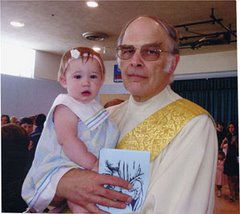Matthew 21:1-11 and Matthew's Passion
During the Easter Season our liturgies
take on a strange look. Holy Thursday – foot washing, reserving
the Blessed Sacrament in a special altar; ending the Mass in silence,
without a dismissal. Good Friday – no Mass at all, the one day of
the year when we don't celebrate the Holy Eucharist. And Holy
Saturday – the Blessing of the Paschal candle and its procession,
the long readings from the Old Testament, and usually, someone gets
baptized or confirmed or receives first Holy Communion. And of
course there is today, where we always begin with the Gospel of
Jesus' triumphant entry into Jerusalem, and then we walk with him
through his passion and death. And we always wonder, perhaps, how
those people who cheered him and lay palm branches before him could
turn around and scream for his blood a few days later.
According to some scholars, it wasn't
quite like that. First of all up to that point Jesus was an
itinerant preacher; sure, people knew about him, but the vast
majority of Jews, especially those who had come from far distances,
had probably never heard of him. Second, as the Jews began their
solemn celebrations it was the practice of the Roman administrator to
parade his troops through town, sort of to remind the Jews that if
they were tempted to rebel, it wasn't a good idea. Third, very few
Jews had any love for the Romans; like conquered people everywhere,
they despised their conquerors.
And then Jesus enters the city. It's
almost like he is mocking the Romans. They are coming in on war
horses with armor and weapons. He is riding a donkey bareback, his
feet probably scraping the ground. The Romans had come through the
main gate; Jesus had entered through a smaller side gate. And the
people noticed, and they loved it. They joined in the mockery,
laying down their cloaks and waving palm branches – these would be
things that the Roman governor would have to pay people to do to
honor him. And why? Why would Jesus do this? Well, he knew he was
going to die and had made peace with that fact in the Garden of
Gethsemene. Perhaps his purpose was to make himself known to as many
people as possible before his Passion began – because it would be
from people who knew of him that his apostles would later form His
church, and probably by the time of the crucifixion everyone in
Jerusalem knew what was going on.
The same scholars that came up with
that idea also felt that the people screaming for Jesus' death later
on would not be these crowds of ordinary people; the people who began
by hating the Romans weren't going to change their minds. The ones
calling for his crucifixion were after all within the court of
Pilate, not out in the streets, and they were undoubtedly the people
who wanted to stay on Pilates good side – maybe some of them were
even being paid to demonstrate.
So Jesus begins his passion by showing
his contempt for power; and power fights back as only power can, with
violence and death. And Jesus goes on to show his contempt for power
by rising from the dead, and no power can ever touch him again.
And when you think about it this way,
we lose our sympathy for Pontius Pilate, who is usually portrayed as
being forced against his will to condemn Jesus. But maybe Pilate was
seething mad and knowing that Jesus had not committed any crime, put
on a show trial so that no one could accuse him of not following
Roman law – because oddly enough, Romans took their law very
seriously.
So when we think about that moment
when Jesus entered Jerusalem on a donkey, perhaps we should see that
part of being holy is refusing to be intimidated by power – even
power that can put you to death – if that power is standing in the
way of the Kingdom of Heaven; if it is standing between us and what
God is calling us to do.



































